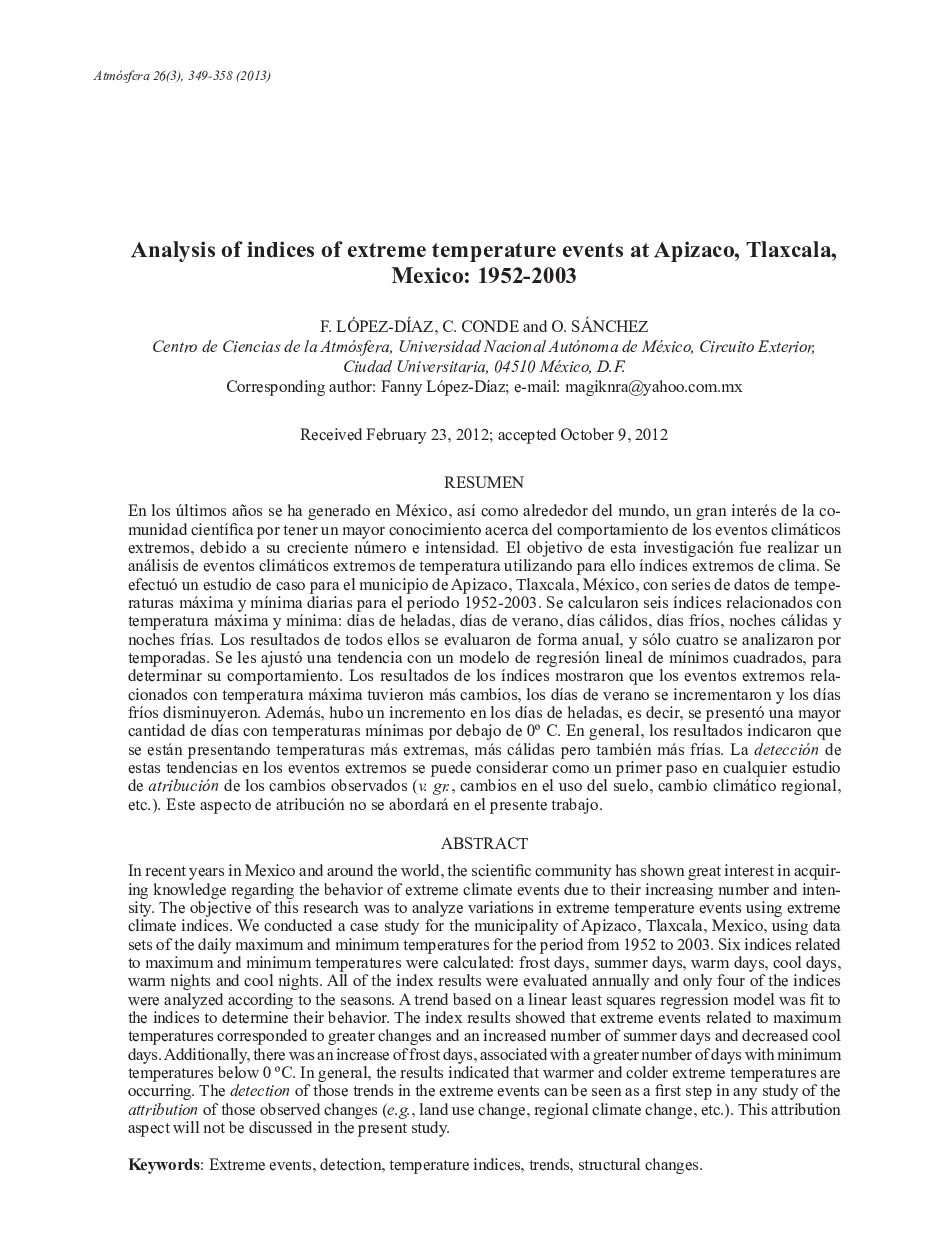| کد مقاله | کد نشریه | سال انتشار | مقاله انگلیسی | نسخه تمام متن |
|---|---|---|---|---|
| 4462054 | 1313458 | 2013 | 10 صفحه PDF | دانلود رایگان |

ResumenEn los últimos años se ha generado en México, así como alrededor del mundo, un gran interés de la comunidad científica por tener un mayor conocimiento acerca del comportamiento de los eventos climáticos extremos, debido a su creciente número e intensidad. El objetivo de esta investigación fue realizar un análisis de eventos climáticos extremos de temperatura utilizando para ello índices extremos de clima. Se efectuó un estudio de caso para el municipio de Apizaco, Tlaxcala, México, con series de datos de temperaturas máxima y mínima diarias para el periodo 1952-2003. Se calcularon seis índices relacionados con temperatura máxima y mínima: días de heladas, días de verano, días cálidos, días fríos, noches cálidas y noches frías. Los resultados de todos ellos se evaluaron de forma anual, y sólo cuatro se analizaron por temporadas. Se les ajustó una tendencia con un modelo de regresión lineal de mínimos cuadrados, para determinar su comportamiento. Los resultados de los índices mostraron que los eventos extremos relacionados con temperatura máxima tuvieron más cambios, los días de verano se incrementaron y los días fríos disminuyeron. Además, hubo un incremento en los días de heladas, es decir, se presentó una mayor cantidad de días con temperaturas mínimas por debajo de 0° C. En general, los resultados indicaron que se están presentando temperaturas más extremas, más cálidas pero también más frías. La detección de estas tendencias en los eventos extremos se puede considerar como un primer paso en cualquier estudio de atribución de los cambios observados (v. gr., cambios en el uso del suelo, cambio climático regional, etc.). Este aspecto de atribución no se abordará en el presente trabajo.
In recent years in Mexico and around the world, the scientific community has shown great interest in acquiring knowledge regarding the behavior of extreme climate events due to their increasing number and intensity. The objective of this research was to analyze variations in extreme temperature events using extreme climate indices. We conducted a case study for the municipality of Apizaco, Tlaxcala, Mexico, using data sets of the daily maximum and minimum temperatures for the period from 1952 to 2003. Six indices related to maximum and minimum temperatures were calculated: frost days, summer days, warm days, cool days, warm nights and cool nights. All of the index results were evaluated annually and only four of the indices were analyzed according to the seasons. A trend based on a linear least squares regression model was fit to the indices to determine their behavior. The index results showed that extreme events related to maximum temperatures corresponded to greater changes and an increased number of summer days and decreased cool days. Additionally, there was an increase of frost days, associated with a greater number of days with minimum temperatures below 0 °C. In general, the results indicated that warmer and colder extreme temperatures are occurring. The detection of those trends in the extreme events can be seen as a first step in any study of the attribution of those observed changes (e.g., land use change, regional climate change, etc.). This attribution aspect will not be discussed in the present study.
Journal: Atmósfera - Volume 26, Issue 3, July 2013, Pages 349–358